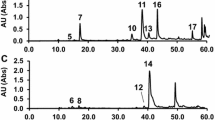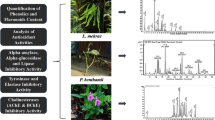Abstract
In the present study, the antioxidative and inhibitory activity of Zingiber officinale Rosc. rhizomes-derived materials (on mushroom tyrosinase) were evaluated. The bioactive components of Z. officinale rhizomes were characterized by spectroscopic analysis as zingerone and dehydrozingerone, which exhibited potent antioxidant and tyrosinase inhibition activities. A series of substituted dehydrozingerones [(E)-4-phenyl-3-buten-2-ones] were prepared in admirable yields by the reaction of appropriate benzaldehydes with acetone and the products were evaluated in terms of variation in the dehydrozingerone structure. The synthetic analogues were examined for their antioxidant and antityrosinase activities to probe the most potent analogue. Compound 26 inhibited Fe2+-induced lipid peroxidation in rat brain homogenate with an IC50 = 6.3±0.4 μM. In the 1,1-diphenyl-2-picrylhydrazyl (DPPH) radical quencher assay, compounds 2, 7, 17, 26, 28, and 29 showed radical scavenging activity equal to or higher than those of the standard antioxidants, like a-tocopherol and ascorbic acid. Compound 27 displayed superior inhibition of tyrosinase activity relative to other examined analogues. Compounds 2, 17, and 26 exhibited non-competitive inhibition against oxidation of 3,4-dihydroxyphenylalanine (L-DOPA). From the present study, it was observed that both number and position of hydroxyl groups on aromatic ring and a double bond between C-3 and C-4 played a critical role in exerting the antioxidant and antityrosinase activity.
Similar content being viewed by others
References
Anderson, S. O., Sclerotization and tanning in cuticle. In Comparative Insect Physiology, Biochemistry, and Pharmacology, Vol. 3. Kerkut, G. A., Gilbert, L. I. (Eds.). Pergamon Press, Oxford, pp. 59–74, (1985).
Bernard, P. and Berthon, J. Y., Resveratrol: an original mechanism on tyrosinase inhibition.Int. J. Cosmet. Sci., 22, 219–226(2000).
Braughler, J. M., Chase, R. L., and Pregenzer, J. F., Oxidation of ferrous iron during peroxidation of lipid substrates.Biochim. Biophys. Acta, 921,457–4644 (1987).
Braughler, J. M., Pregenzer, J. F., Chase, R. L., Duncan, L. A., Jacobsen, E. J., and McCall, J. M., Novel 21-amino steroids as potent inhibitors of iron-dependent lipid peroxidation.J. Biol. Chem., 262, 10438–10440 (1987).
Braughler, J. M., Philip, S., Barton, R. L., Chase, J. F., Pregenzer, E. J., Jacobsen, F. J., Van Doornik, J. M. T., Donald, E. A., and Gordon, L. B., Novel membrane localized iron chelators as inhibitors of iron-dependent lipid peroxidation.Biochem. Pharmacol., 37, 3853–3860 (1988).
Connell, D. W. and Sutherland, M. D., A re-examination of gingerol, shogaol, and zingerone, the pungent principles of ginger(Zingiber officinale Roscoe).Aust J. Chem., 22, 1033–1043(1969).
CoSeteng, M. Y., and Lee, C. Y., Changes in apple poly-phenoloxidase and polyphenol concentrations in relation to degree of browning.J. Food Sci., 52, 985–989 (1987).
De Bemardi, M., Vidari, G., and Vita-Finzi, P., Dehydrozingerone from Aframomum giganteum.Phytochemistry, 15, 1785–1786(1976).
Denniff, P. and Whiting, D. A., Synthesis of (±)-[6]-gingerol (pungent principle of ginger) and relatives via directed aldol reactions. J. Chem. Soc, Chem. Commun., 712-713 (1976).
Fridovich, I., The biology of oxygen radicals.Science, 201, 875–880(1978).
Gutteridge, J. M. C., Richmond, R., and Halliwell, B., Inhibition of the iron-catalysed formation of hydroxyl radicals from Superoxide and of lipid peroxidation by desferrioxamine.Biochem. J., 184, 469–472 (1979).
Halliwell, B., Murcia, M. A., Chirico, S., and Aruoma, O. I., Free radicals and antioxidants in food andin vivo: what they do and how they work.Crit. Rev. Food Sci. Nutr., 35, 7–20 (1995).
Huang, Y. C., Wu, B. N., Yeh, J. L., Chen, S. J., Liang, J. C., Lo, Y. C., and Chen, I. J., A new aspect of view in synthesizing new type β-adrenoceptor blockers with ancillary antioxidant activities.Bioorg. Med. Chem., 9, 1739–1746 (2001).
Kitagawa, S., Fujisawa, H., and Sakurai, H., Scavenging effects of dihydric and polyhydric phenols on Superoxide anion radicals, studied by electron spin resonance spectrometry.Chem. Pharm. Bull., 40, 304–307 (1992).
Ko, F. N., Liao, C. H., Kuo, Y. H., and Lin, Y. L., Antioxidant properties of demethyldiisoeugenol.Biochim. Biophys. Acta, 1258, 145–152(1995).
Laranjinha, J., Almeida, L., and Madeira, V., Reactivity of dietary phenolic acids with peroxyl radicals: antioxidant activity upon low density lipoprotein peroxidation.Biochem. Pharmacol., 48, 487–494(1994).
Lee, C. Y., Kagan, V., Jaworski, A. W., and Brown, S., Enzymatic browning in relation to phenolic compounds and polyphenoloxidase activity among various peach cultivars.J. Agric. Food Chem., 38, 99–101 (1990).
Maeda, K. and Fukuda, M.,In vitro effectiveness of several whitening cosmetic components in human melanocytes.J. Soc. Cosmet. Chem., 42, 361–368 (1991).
Mason, H. S. and Peterson, E. W., Melanoproteins. I. Reactions between enzyme-generated quinones and amino acids.Biochim. Biophys. Acta, 111, 134–146 (1965).
Mellors, A. and Tappel, A. L., The inhibition of mitochondrial peroxidation by ubiquinone and ubiquinol.J. Biol. Chem., 241, 4353–4356(1966).
Pomerantz, S. H., Separation, purification, and properties of two tyrosinases from Hamster Melanoma.J. Biol. Chem., 238, 2351–2357(1963).
Raper, H. S., The aerobic oxidases.Physiol. Rev., 8, 245–282 (1928).
Sala, T. and Sargent, M. V., Depsidone synthesis. Part 14. The total synthesis of psoromic acid: isopropyl ethers as useful phenolic protective groups.J. Chem. Soc. Perkin Trans. I, 2593–2598(1979).
Sanchez-Ferrer, A., Rodriguez-Lopez, J. N., Garcia-Canovas, F., and Garcia-Carmona, F., Tyrosinase: A comprehensive review of its mechanism.Biochim. Biophys. Acta, 1247, 1–11 (1995).
Scott, A. I., Interpretation of the ultraviolet spectra of natural products. Pergamon Press, New York, p. 119, (1964).
Shirota, S., Miyazaki, K., Aiyama, R., Ichioka, M., and Yokokura, T., Tyrosinase inhibitors from crude drugs.Biol. Pharm. Bull., 17, 266–269 (1994).
Staprans, I., Pan, X. M., Miller, M., and Rapp, J. H., Effect of dietary lipid peroxides on metabolism of serum chylomicrons in rats.Am. J. Physiol., 264, G561-G568 (1993).
Terao, J., Karasawa, H., Arai, H., Nagao, A., Suzuki, T., and Takama, K., Peroxyl radical scavenging activity of caffeic acid and its related phenolic compounds in solution.Biosci. Biotech. Biochem., 57, 1204–1205 (1993).
Author information
Authors and Affiliations
Corresponding author
Rights and permissions
About this article
Cite this article
Kuo, PC., Cherng, CY., Jeng, JF. et al. Isolation of a Natural Antioxidant, Dehydrozingerone from Zingiber officinale and Synthesis of Its Analogues for Recognition of Effective Antioxidant and Antityrosinase Agents. Arch Pharm Res 28, 518–528 (2005). https://doi.org/10.1007/BF02977752
Received:
Issue Date:
DOI: https://doi.org/10.1007/BF02977752




